Introduction
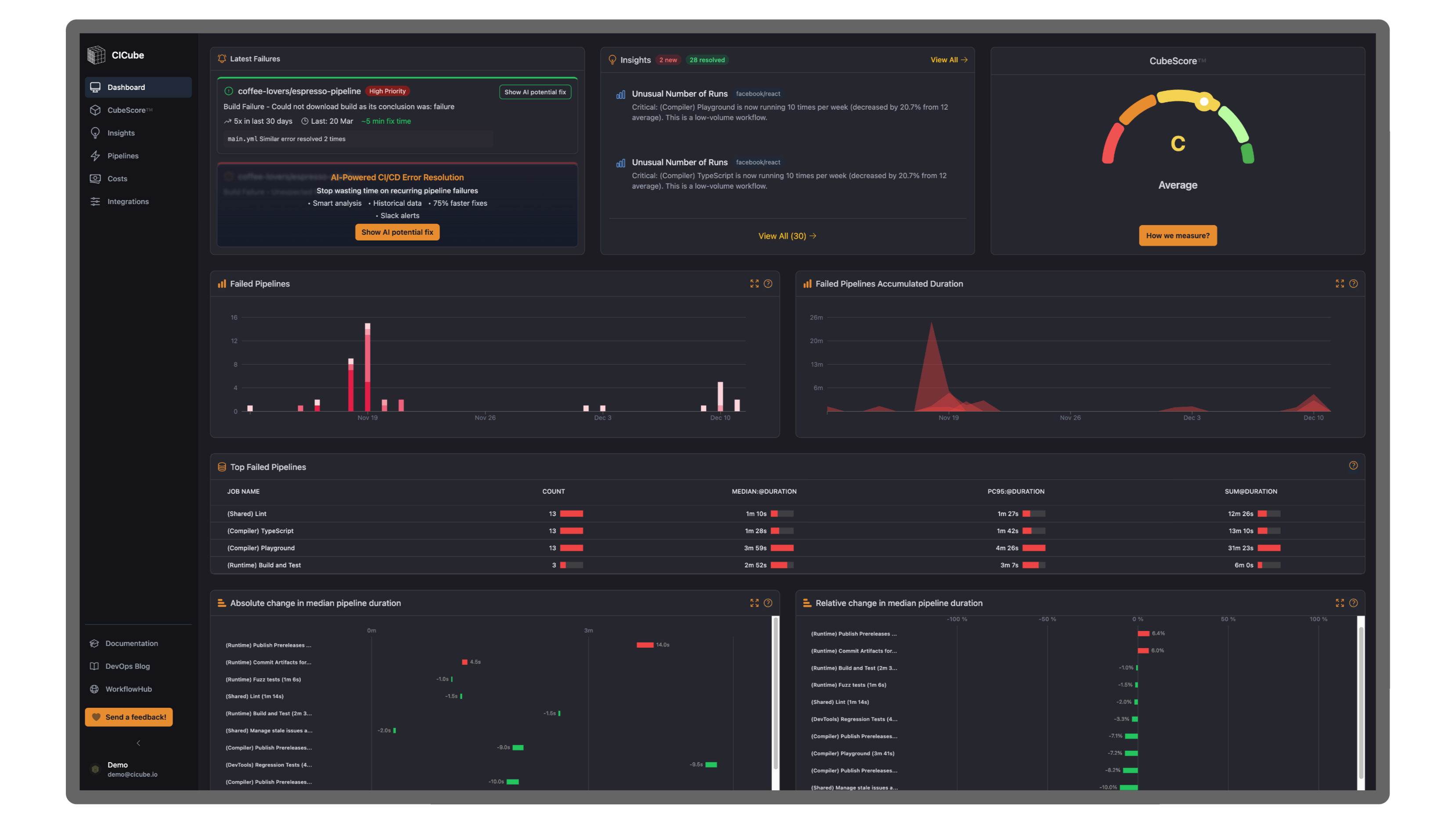
Well, we wanted to let you know about one thing we've been working on: CICube, the platform positioned to be your default GitHub Actions dashboard for monitoring and improving CI pipeline performance.
Whether you've faced slow builds, failing tests, or those pipelines which always seem to break at the worst time, CICube may be exactly what you need.
You can see the live demo of CICube without any sign-up here.
At its core, CICube offers four must-haves:
- Clearly see your CI health with CubeScore™️ by tracking key CI North Star metrics: Success Rate, MTTR [Mean Time to Recovery], Duration, and Throughput. These metrics will provide the insight you need into your GitHub Actions workflows.
- Actionable insights for the non-CI expert. CICube provides AI-driven recommendations to help with issues like decreasing success rates, increasing durations, or test failures—all based on the metrics that matter most to your GitHub Actions pipelines.
- Proactive monitoring: Monitor the most important metrics, such as pipeline executions, failed runs, and median duration, with detailed charts and historical reports to uncover bottlenecks way before blocking. CICube will surface problems well in advance for GitHub Actions CI monitoring.
- Weekly reporting: This produces a weekly report summarizing key metrics, alerts, and trends from the past week. Reports like these keep you updated on your infrastructure's health and performance through highlighting the important activities and possible issues that you don't have to keep an eye on every now and then.
Rather than forcing them to dig through logs trying to figure out where an error occurred, CICube centralizes everything in one intuitive dashboard to make gathering real insights faster and easier. Currently, CICube supports only GitHub Actions, but other providers such as GitLab and Jenkins are planned to be added to the platform very soon.
Steps we will cover in this post:
- Why We Built CICube?
- What CICube Does?
- Measuring CI Performance with CubeScore™️
- Key Benefits of CICube
- Specific Scenarios Where CICube Can Help
Let me break down why we built it and how it can help with your CI challenges.
Why We Built CICube?
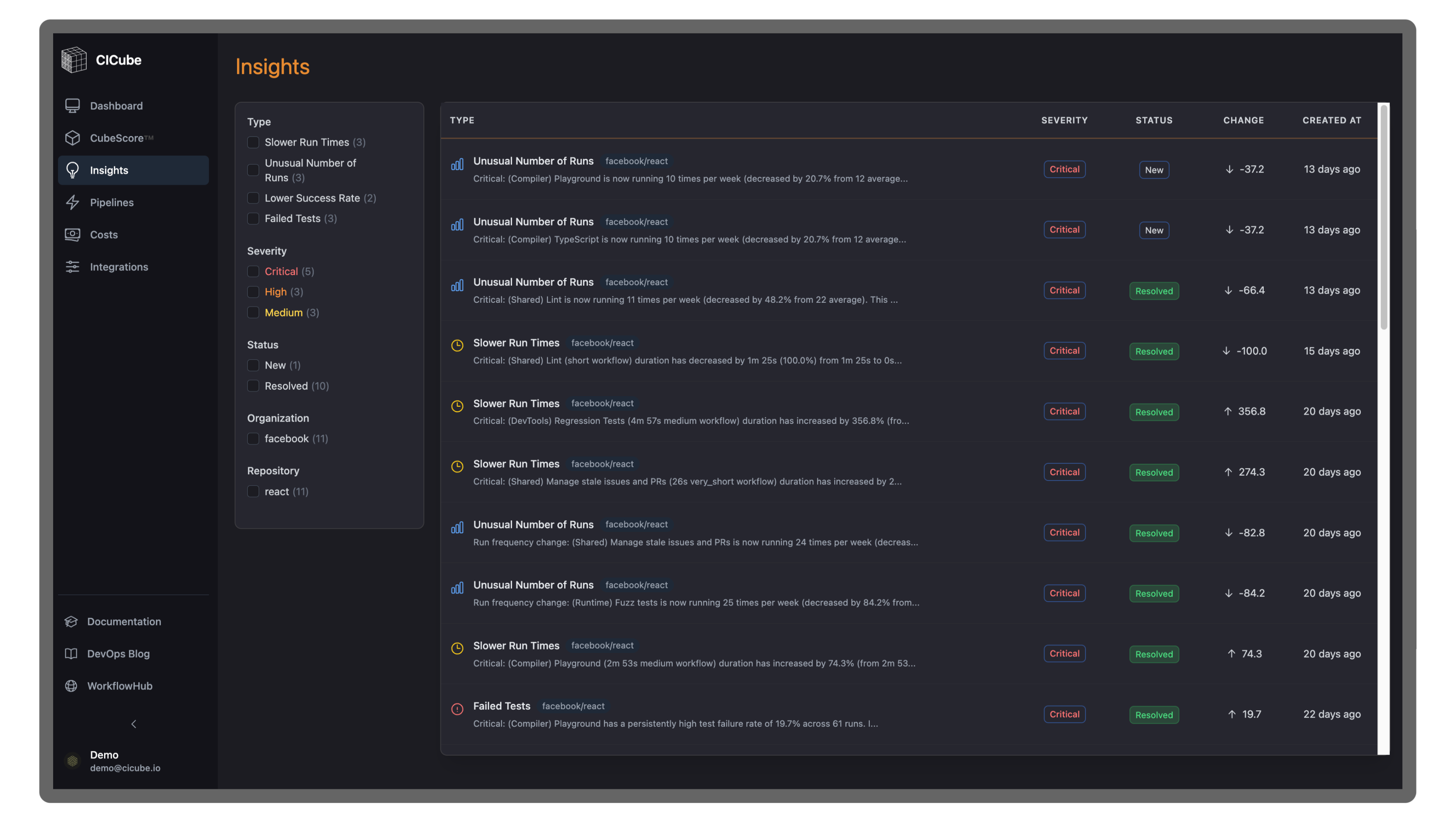
As a team of DevOps, Software, and Infrastructure developers, we have experienced the frustration of slow builds, failing tests, and pipelines breaking at the worst possible time. We had to realize that there must be a better way to be on top of CI processes in general, but particularly GitHub Actions CI monitoring, without spending hours digging through logs and trying to make sense of data.
That's why we built CICube, a tool which tracks key CI North Star metrics—Success Rate, MTTR (Mean Time to Recovery), Duration, and Throughput—not just stops there but provides actionable insights to improve CI pipeline performance while reducing downtime and hastening delivery by simplifying GitHub Actions performance monitoring. CICube automatically identifies bottlenecks, failed workflows, and those areas which need optimization. Rather than being reactive, we wanted to be proactive—catching issues before they became bigger problems.
Another big reason for building CICube was saving time and resources. We wanted a tool that would help optimize GitHub Actions' workflows, reduce associated costs, and give clarity on making decisions based on data. We wanted to spend less time debugging and more time building and improving the products.
So, CICube was born out of our own pain related to better CI pipeline management and we're excited to share it with others facing the same pain.
What CICube Does?
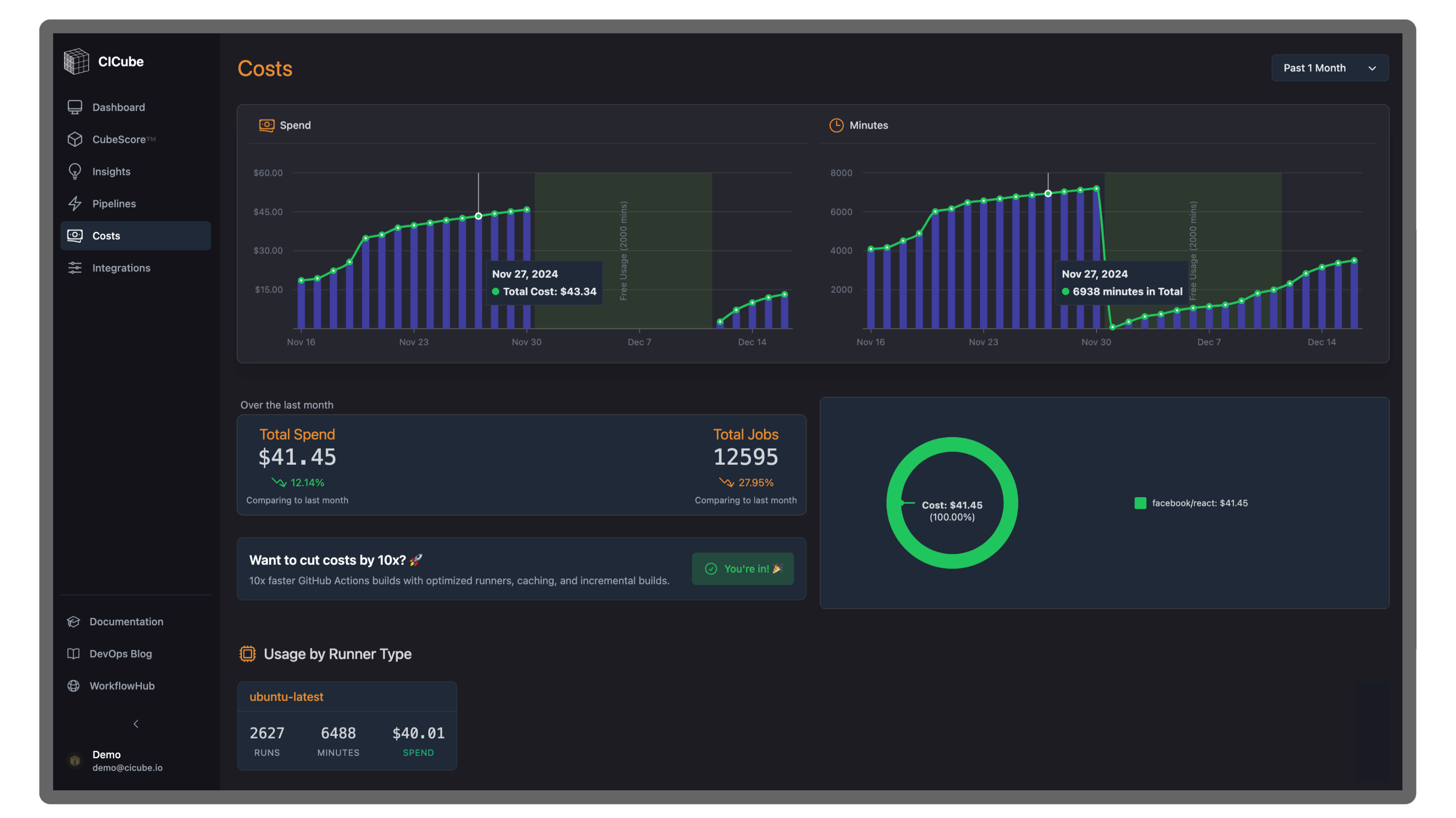
CICube is built to provide a comprehensive view of your CI pipeline performance with a focus on GitHub Actions workflows. You can track and optimize critical metrics showing the real health of your pipeline, among which: Success Rate, MTTR, Duration, and Throughput.
- Duration: Whether a pipeline is completed takes how much time is defined by the duration. Skilled teams minimize this to enable quicker delivery without causing bottlenecks.
- Success Rate: Successfully run rate on your GitHub Actions pipelines. This is something where the higher, the better to reduce disruptions due to this factor and waste less crucial time in solving these problems.
- Throughput: Refers to the amount of CI workflows that your team finishes over a period. This can indicate how efficient your pipelines are in handling workload. High throughput means effective work delivery because more pipelines finished in a short time.
- MTTR - Mean Time to Recovery: This is how long it takes for your team to recover once the GitHub Actions pipeline has failed. If the MTTR score is lower, this would mean your team resolves the issues faster and hence contributes to lesser hindrance in development progress.
But CICube is more than metrics tracking—it's about actionable insights powered by AI. Such insights enable you to optimize your GitHub Actions workflows by exactly showing you where this improvement is needed, whether it is decreasing success rates, long-running tasks, or flagging pipelines with frequent failures. And this is where CICube gives you the data required to make sure issues are addressed before they become a bother.
Another key feature of CICube is proactive monitoring. It constantly monitors your workflows, sends you real-time alerts in case something goes wrong, and helps you take immediate action on the same to avoid extended downtime.
Another strong suit of CICube is in tracking historical metrics. It features a detailed reporting capability, giving one insight into how their pipelines have performed over time. Therefore, it lets one identify patterns, track improvements, and drive data-informed decisions toward future optimization of one's CI pipeline. We also know that collaboration is key. CICube lets you share performance data across teams with commit-centric views and GitHub comments, making alignment seamless for all stakeholders.
In short, CICube will help you monitor, optimize, and improve your workflows—Save more time with troubleshooting and free your team up to build.
Measuring CI Performance with CubeScore™️
One of the key features of CICube is CubeScore™️, a system we developed to help teams easily track and improve their CI performance. CubeScore™️ is designed to take complex data and present it in a way that’s easy to understand, giving you a clear view of how well your pipeline is running through a clean GitHub Actions dashboard.
CubeScore™️ highlights which outlier runs are pulling down your performance. It displays those outlier runs in a table with details like failure reasons or taking excessively long. Along with this, CubeScore™️ salso advises you on how you can contribute to improving things, whether it's step optimization or addressing bottlenecks in the workflow.
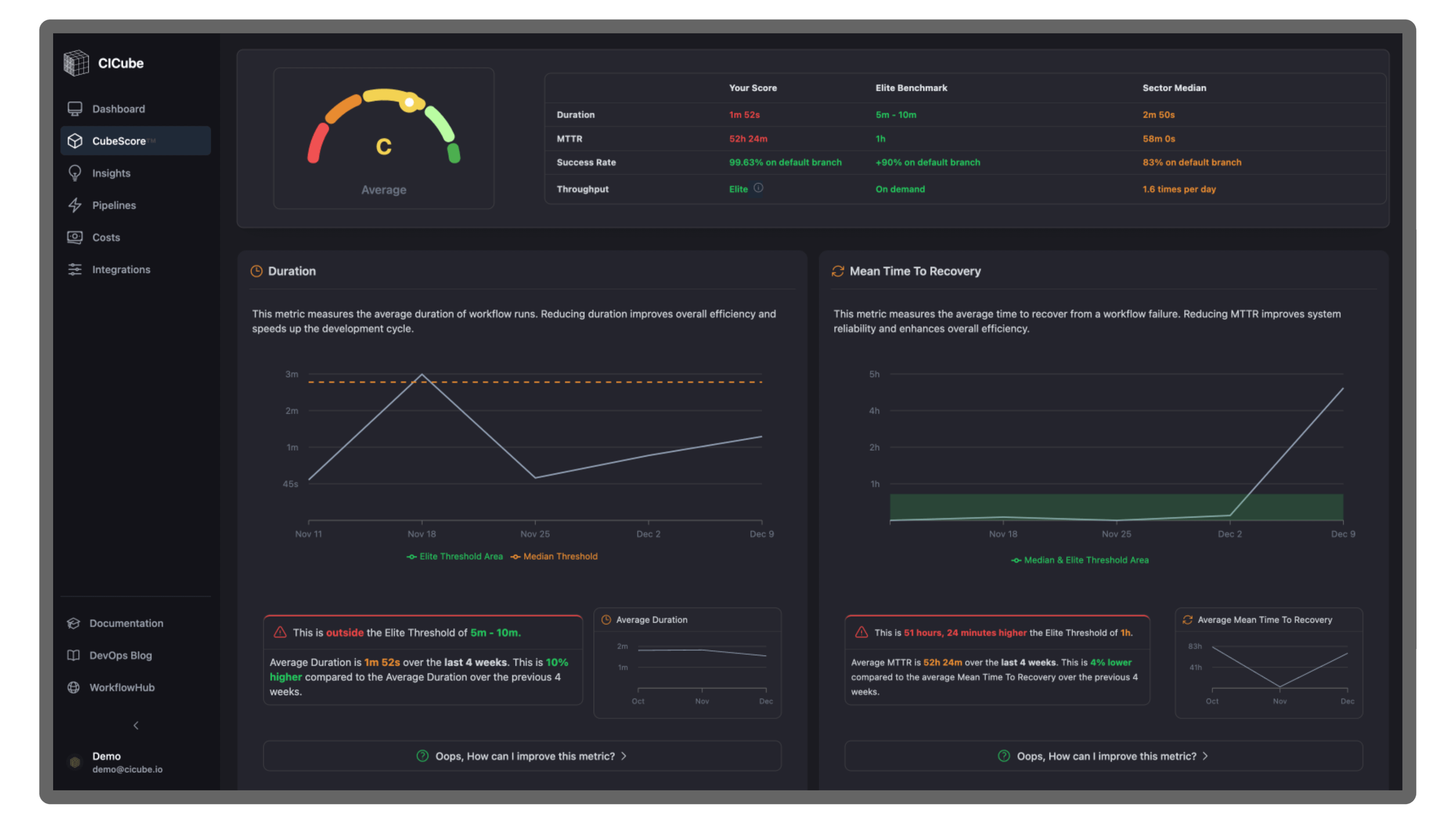
Key Metrics Tracked by CubeScore™️
CubeScore™️ is built around four critical metrics, often referred to as North Star Metrics in the world of CI/CD. These metrics are essential for understanding the health of your GitHub actions pipelines:
-
Success Rate: This is the percentage of successful pipeline runs. A high success rate means your pipelines are running smoothly with fewer failures, leading to less downtime and more reliable releases.
-
MTTR (Mean Time to Recovery): MTTR is the time it takes your team to recover from pipeline failure. The faster the recovery, the less it impacts your development. This is a characteristic of a high-performing team.
-
Duration of Workflow Runs: This tracks how long it takes for a pipeline to complete from start to finish. Shorter durations mean faster feedback, which helps teams iterate more quickly and ship code faster.
-
Throughput: Throughput measures how many pipeline runs your team completes within a certain period. High throughput indicates that your team is delivering more work in less time, a key indicator of efficiency.
How CubeScore™️ Works?
CubeScore™️ takes these four key North Star metrics and combines them into an overall score that reflects the health and efficiency of your pipeline. It’s not just about tracking individual numbers; CubeScore™️ compares your metrics against industry benchmarks, like Elite and Median performance levels, giving you essential context for evaluating your dashboard. This way, you know not only how your team is doing but also how you stack up against others in the industry.
-
Elite teams represent the top-performing teams in the industry—those that consistently deliver software faster, with fewer failures, and recover quickly from issues.
-
Achieving Elite Status means your team is performing at the highest level across North Star metrics, leading to better GitHub Actions CI monitoring and more efficient workflows.
-
Median performance reflects the average team performance, providing a benchmark to measure your progress. This helps you understand not only how your team is doing but also how it compares with other teams in similar industries.
Visualizing CubeScore™️
One of the strengths of CubeScore™️ is its ability to visualize these key metrics in your GitHub Actions dashboard. The data is presented in intuitive charts and graphs, making it easy to spot trends, identify bottlenecks, or pinpoint where things are going wrong. You can get a high-level view at a glance or drill down into specific metrics when you need more detail. This makes CubeScore™️ a powerful tool for continuous improvement in your GitHub Actions CI monitoring.
Using CubeScore™️ to Drive Improvements
CubeScore™️ isn’t just about tracking your pipeline performance—it’s a tool for driving real improvement. By regularly reviewing your CubeScore™️, you can easily spot where your workflows need attention, whether it’s reducing recovery times, increasing success rates, or cutting down on long-running tasks. These insights help you make informed decisions about what to fix and when, so you’re always improving your pipeline efficiency.
Real-World Impact of CubeScore™️
Let’s say your MTTR is high compared to industry benchmarks. CubeScore™️ will highlight this, providing the data you need to focus on improving recovery times. Over time, as your MTTR improves, you’ll see this reflected in your CubeScore™️, showing that your efforts are paying off. The result? Faster releases, fewer issues, and a more efficient development process overall, all visible directly from your dashboard.
Key Benefits of CICube
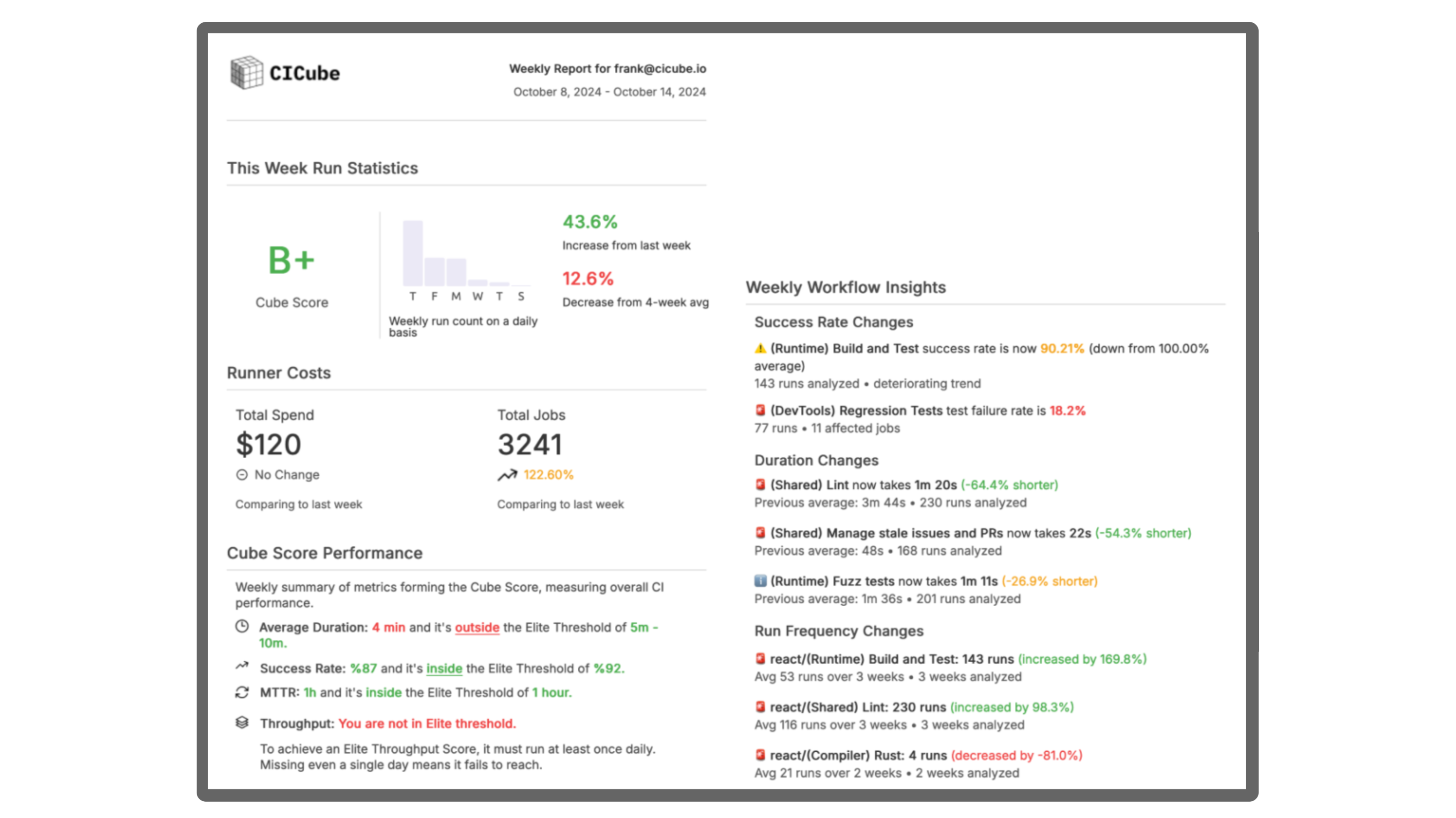
- Crystal Clear Insights, No More Hassle: CICube gives you an insight into your workflow performance and surfaces key CI metrics without digging through logs.
- Performance Tracking & Cost Efficiency: Tracking of your GitHub Actions CI metrics is easily done, and finding out the bottlenecks followed by the optimization of workflows will be helpful in saving lots of time and reducing costs.
- Alerts and Notifications: The system of alerts and notifications informs your team in real time about critical metrics, job duration, and pipeline failures. Besides, you can customize notifications by email, Microsoft Teams, and Slack. That's how you can immediately react to keep optimum monitoring of GitHub Actions CI and reduce your downtimes.
- Collaborative Workflows: Share performance data and insights across teams via a dashboard to more easily identify problems and optimize workflow.
- Seamless Integration & Proactive Monitoring: CICube is integrated right into GitHub Actions, providing immediate warnings for CI monitoring so you can catch issues before they balloon.
- Real-Time Visualization: See your GitHub Actions metrics in intuitive visualizations. Understand your performance in real time with the GitHub Actions dashboard.
- Historical Metrics Tracking: Tracking of key CI metrics over time, enabling reporting and assisting teams in effecting data-driven improvements.
- Pipeline Reliability: It enables one to track failures within a very short time by linking issues with particular commits, thus making the pipeline reliable.
- Take Better Data-Driven Decisions: Utilize out-of-the-box dashboards that source data directly from GitHub Actions for detailed analysis to help drive smarter data-driven decisions.
- DevOps-Focused: CICube increases developer productivity by optimizing workflows; spending less time debugging issues, therefore overall efficiency of Continuous Integration is achieved.
Specific Scenarios Where CICube Can Help
Situations, most specifically, where CICube can assist:
The continuous integration pipeline can be quirky, and the use of GitHub Actions can be even trickier. In fact, all of us have gone through bad experiences with pipelines failing to run for very long and repeated failures—a nightmare through the entire development stream.
-
"Our pipeline always breaks after a merge, now what?"
CICube enables you to trace a case of failure back to a certain commit or merge. It offers a commit-centric dashboard view, precisely highlighting where the failure occurred. Knowing this, you should be able to swiftly resolve the problem and prevent breakdowns from recurring for the foreseeable future. -
"Why is my build time so long?"
It keeps track of the time taken in every workflow execution and displays the bottleneck and steps that take too much time. The analysis of the duration of a build gives you the opportunity to point out where the time is wasted, by suggesting ways to improve the optimization of steps and the parallelization for better build times. -
"We get these flaky tests, failing inconsistently."
It pinpoints workflows that work inconsistently, flags flaky tests, offers granular reporting on which tests prove the most unreliable, and gives recommendations on how to fix these kinds of tests for better success rates. -
"How can we reduce hours wasted when a pipeline goes down?"
CICube does provide actionable insights into improving MTTR because it will quickly find out what the failure cause was, or where the breakdown occurred in the GitHub Actions dashboard to recover such that it keeps your team moving forward. -
"We want to know which are the pipelines that cost us more."
With CICube's cost optimization monitoring features (in development), you can see where time and resources are being wasted, pointing out the unnecessary steps in one workflow that are taking too much time and thus helping in the optimization of those processes to cut down on CI costs. -
"I want to know if our pipeline performance is improving over time."
It provides the functionality of tracking historical CI metrics, enabling you to see how your pipeline has performed over time. You can view use of Success Rate, Throughput, and MTTR to measure improvement and adjust strategy as needed. -
"We have too many people assigned to the same pipeline, which is causing delays."
CICube gives insight into how your teams interact with your GitHub Actions pipelines by identifying points at which team activities may be causing sluggishness or conflict and providing guidance on better collaboration and workflow management in order to streamline. -
"Our group is having issues with managing the parallel job and pipeline queue times."
Our dashboard lets you track parallel jobs and queue times. Analyzing these metrics will enable you to optimize pipeline parallelism, reducing queue delays that typically make workflows slower than they could be. -
"We will need to provide a means of monitoring and reporting across multiple CI pipelines."
CICube is integrated with multiple CI providers, pulling data into one dashboard. You can filter and analyze performance across different pipelines and branches all from within one easy-to-manage environment and overview your CI/CD health. -
"I want to proactively fix issues before they slow down the team."
Thanks to proactive monitoring and immediate alerts, CICube will let you know through its dashboard when something is off—something like a spike in failure rates or a slow build time—so you can fix issues before they can affect the productivity of your team.
Conclusion
CICube is designed to make your development process faster, smoother, and more cost-effective.
By simplifying CI monitoring and offering proactive alerts, real-time insights, and easy integration with GitHub Actions, CICube takes the guesswork out of pipeline management. It's the tool that empowers teams to make data-driven decisions, improving performance and reducing costs.